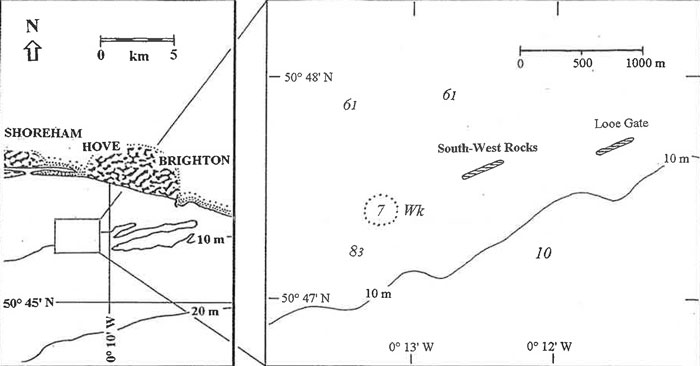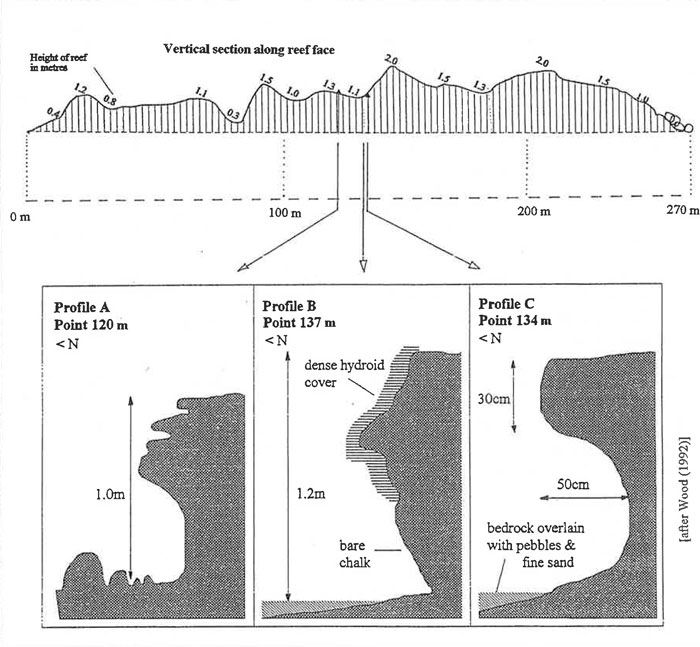SUSSEX MARINE SITES OF NATURE CONSERVATION IMPORTANCE
| Site: South-West Rocks | Ref. No. 9 | ||||||
| Location: 4.5 km SW of Hove | Other conservation designation?: No |
||||||
| Lat./Long. position of centre of site: 50° 47' 60" N 0° 12' 50" W |
OS grid ref. of centre of site: TQ 262 009 |
Author: Robert Irving |
|||||
| Sea bed type: Chalk cliff, sand and pebbles. |
Depth range (below chart datum): 8-11 m |
Date identified: November 1995 |
|||||
Summary
South-West Rocks is a length of exposed vertical chalk cliff, 270 m long, northward-facing and running approximately 240°/60°. It is believed (though not proven) that this is the same chalk stratum which forms the Worthing Lumps (mSNCI 8), Looe Gate (10) and Ship Rock (11), following the 10 m depth contour. The general height of the cliff is 1.0 m, though in places (especially to the east of the central point) it reaches a maximum height of 2.0 m. At the western end the cliff face diminishes to become covered by sand. The vertical face of the cliff is undercut at its base, giving way to a sea bed of fine sand and pebbles. Leading away from the top of the cliff is a relatively flat chalk plateau which again gradually becomes covered by sand, and pebbles. Occasional rock mills, circular holes formed by flint pebbles being swirled around in the currents, are present.
Biological Description
The area most densely covered by marine life is the upper part of the vertical face extending onto the upper horizontal surface. A dense animal turf dominates, with the hydroids being common, particularly the stalks of Tubularia indivisa. Foliose red algae occur on the upper horizontal surface though plants tend to be small and silt-covered. The green alga Bryopsis plumosa is also found occasionally. Other faunal components of the 'turf' include sponges, principally Esperiopsis fucorum and Dysidea fragilis, and bryozoans such as Flustra foliacea and Bugula spp. The soft coral Alcyonium digitatum may be common in some areas, though their occurrence is sporadic. The vertical chalk cliff face is peppered by many small holes made by boring piddock bivalves. In 1990, a small group of burrowing sea cucumbers, thought to be Aslia lefeveri, were found occupying abandoned vertical piddock holes (Wood 1992). This is believed to be the only record of burrowing sea cucumbers in the eastern part of the Channel, though they have not been recorded from this site since. The cowrie Trivia arctica may be common, feeding on colonial stalked sea squirts Aplidium sp. Crustaceans are not as common as one might expect, though certain fish species, such as bib Trisopterus luscus, poor cod Trisopterus minutus, ballan wrasse Labrus bergylta and goldsinny Ctenolabrus rupestris, are frequently seen.
The flora and fauna at this site appears to have changed considerably during the period from 1984/5 to 1994. Records made in 1984/5 listed 47 algal species, yet only 7 were recorded in 1990. The hydroid turf composition in 1990 included Hydrallmania falcata and Obelia dichotoma (neither recorded in 1984/5), but did not include Eudendrium ramosum nor Sertularia cupressina which were respectively abundant and common in 1986.
References:Irving, R. A. . Report of the West Sussex Seasearch Project, 1994: Littlehampton to Brighton Unpublished Report, Coldwaltham, West Sussex |
|||||||
| Sussex SEASEARCH dive nos.: 94/161-163,185-187 | |||||||
| SEMCS Chalk Cliffs Project, site log nos.:1,4,7,8,& 20 | |||||||
| Sussex Sublittoral Survey site no.: 42 | |||||||
Site Location

Diagrammatic representation of site: South-West Rocks


:Link to this page
Copyright Sussex Biodiversity Records Centre © 2025